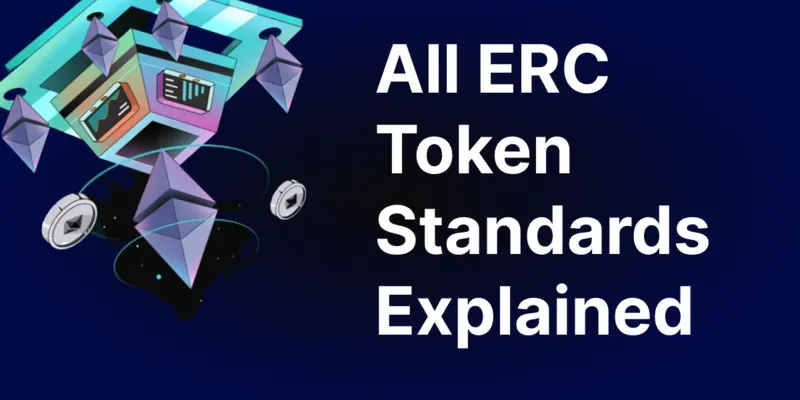ERC Token Standards: Driving Innovation and Interoperability on the Ethereum Blockchain

ERC (Ethereum Request for Comments) standards have played a pivotal role in shaping the Ethereum blockchain ecosystem. These standards provide guidelines and specifications for the creation and implementation of tokens, smart contracts, and decentralized applications (dApps) on the Ethereum network. This scholarly article explores the history, importance, and popular ERC standards in use today. Additionally, it delves into emerging trends and developments in the ERC standard space, offering insights into the future of this critical component of the Ethereum ecosystem.
The Rise of ERC Standards
Since its inception, the Ethereum blockchain has become a hub of innovation and development. ERC standards emerged as a crucial component of this ecosystem, providing a standardized framework for the creation and management of tokens, smart contracts, and dApps. ERC standards have not only facilitated interoperability but also established best practices and common language for developers to follow.
Understanding ERC Standards
ERC-20: Fungible Tokens
The ERC-20 standard, introduced in 2015, is the most widely used token standard on the Ethereum network. It enables the creation of fungible tokens, which are identical in value and interchangeable. This standard has revolutionized the token economy, allowing for the creation of utility tokens, stablecoins, and security tokens.
ERC-721: Non-Fungible Tokens (NFTs)
ERC-721 has gained significant popularity in recent years, especially with the rise of NFTs. This standard enables the creation of unique and non-interchangeable tokens, representing assets like digital art, collectibles, and real estate. ERC-721 tokens have opened up new avenues for ownership, provenance, and trading in the digital world.
ERC-777: Enhanced Token Functionality
ERC-777 is an improvement over the ERC-20 standard, introducing a new "send" function for more efficient token transfers. With ERC-777, token transfers can be completed in a single transaction, reducing transaction fees and enhancing user experience. It also includes features like an operator system and callback functions, offering greater flexibility in token ownership and management.
ERC-1155: Combined Fungible and Non-Fungible Tokens
ERC-1155 is a unique token standard that allows for the creation of both fungible and non-fungible tokens within a single contract. This innovation simplifies the management of multiple token types and enables the creation of semi-fungible tokens, blending fungible and non-fungible properties. ERC-1155 has found applications in gaming, collectibles, and various industries.
Significance and Adoption of ERC Standards:
Interoperability and Compatibility ERC standards have played a vital role in establishing interoperability between different tokens and dApps on the Ethereum network. By adhering to these standards, developers ensure that their tokens can seamlessly interact with other tokens, wallets, and exchanges, fostering a more connected and efficient ecosystem.
Token Creation and Widespread Adoption The availability of ERC standards has democratized token creation, allowing individuals and businesses to tokenize their assets and ideas easily. The ease of creating ERC-compliant tokens has contributed to the proliferation of various token-based projects, fueling innovation and driving the adoption of blockchain technology.
Use Cases:
Utility Tokens, Stablecoins, and Security Tokens ERC standards have been instrumental in the creation of utility tokens, enabling functionalities such as rewards, access rights, and governance in decentralized applications. Additionally, they have facilitated the development of stablecoins, providing price stability and facilitating transactions within the blockchain ecosystem. Furthermore, ERC standards have paved the way for security tokens, representing ownership in traditional assets like real estate and company shares.
Exploring Emerging ERC Standards:
ERC-165: Standardized Interface Detection ERC-165 provides a standardized way for contracts and dApps to check whether another contract implements a particular interface. This enhances interoperability and simplifies the integration of different applications.
ERC-223: Enhanced Token Transfers ERC-223 aims to improve the ERC-20 standard by introducing a function to handle incoming token transactions. This prevents the loss of tokens when mistakenly sent to incompatible contracts, improving user experience and security.
ERC-621: Fractional Asset Ownership ERC-621 extends the functionality of ERC-20 and ERC-223 by allowing tokens to be burned or redeemed for other assets. This feature enables fractional ownership of assets and provides flexibility for token holders to exchange their tokens for different assets.
ERC-865: Cost-Effective Token Transfers ERC-865 introduces a mechanism where token transfers can be paid for by someone other than the sender. This reduces the burden of gas fees for users and dApps, making token transfers more accessible and cost-effective.
ERC-827: Advanced Transaction Data ERC-827 enhances ERC-20 and ERC-223 standards by allowing additional transaction data, facilitating integration with existing financial systems and applications.
ERC-884: Fractional Ownership of Assets ERC-884 enables the representation of fractional ownership of real-world assets on the Ethereum blockchain, providing transparency, liquidity, and new investment opportunities.
ERC-4626: Streamlining Yield-Bearing Vaults ERC-4626 proposes a standard API for tokenized yield-bearing vaults, simplifying their implementation and enabling more efficient access to yield within various applications.
Future Prospects and Conclusion:
Advancements and Innovations in ERC Standards ERC standards continue to evolve and adapt to meet the changing needs of the Ethereum ecosystem. The ongoing development of new standards and improvements to existing ones reflect the commitment of the Ethereum community to drive innovation and enhance blockchain technology.
The Role of ERC Standards in the Future Ethereum Ecosystem ERC standards will remain a crucial part of the Ethereum ecosystem, providing a solid foundation for the development and deployment of decentralized applications and tokens. As the blockchain industry continues to grow, ERC standards will play an essential role in ensuring interoperability, security, and scalability, fostering the adoption of blockchain technology across various sectors.
In conclusion, ERC standards have revolutionized the Ethereum blockchain ecosystem by providing a common language and best practices for token creation and smart contract development. These standards have facilitated interoperability, encouraged widespread adoption, and opened up new possibilities for innovation. As the Ethereum ecosystem continues to evolve, ERC standards will remain at the forefront of driving future advancements and shaping the decentralized future.
